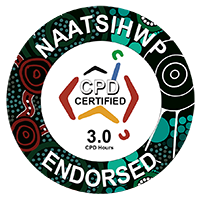Good Medicine Better Health
Good Medicine Better Health: Quality use of medicines foundation
This course consists of two 45-minute modules that aim to increase knowledge about the quality use of medicines (QUM) for Aboriginal and Torres Strait Islander Health Workers and Health Practitioners and community members. Participants will gain an understanding about why QUM is important and how to practice QUM in clinics and community settings. The modules include information about medicines and how to read medicine labels, the safe use of medicines, identifying potential side-effects and interactions, safe storage and disposal of unused medicines.
-
Cost: free
Accreditation
The National Association of Aboriginal and Torres Strait Islander Health Workers and Practitioners has endorsed this activity with 3 CPD Hours.
Endorsement period: 26/07/2021-26/07/2022.

It is recommended that 1.5 CPD hours be recorded for the purposes of self-directed CPD.
About
These modules have been developed by NPS MedicineWise in consultation with the Good Medicine Better Health Advisory Group and the following organisations: National Association of Aboriginal and Torres Strait Islander Health Workers and Practitioners (NAATSIHWP), National Aboriginal Community Controlled Health Organisation (NACCHO), Aboriginal Medical Services Alliance Northern Territory (AMSANT) with contributions by Dr Jason Agostino and James Harris (Djinda Creative Resources).
This learning activity aims to increase knowledge about the quality use of medicines (QUM), and to share that knowledge with community members.
Learning outcomes
Upon completion of each module the learner should be able to:
Module 1 - QUM principles
- Describe how quality use of medicines (QUM) promotes good health and raises awareness, knowledge and skills of consumers and the community.
- Explain what the active ingredient of a medicine is and where to find the active ingredient on medicine labels and packaging.
- Describe situations where medicines might be contraindicated.
- List common medicine side effects and explain to clients the signs and symptoms to look out for.
Module 2 - Putting QUM into action
- Describe how to improve the safe use of medicines.
- Explain the different parts of medicine labels for prescription-only medicines and pharmacy medicines.
- Describe how best to store medicines, including when travelling.
- Explain what to do with unwanted, unused or out-of-date medicines.
